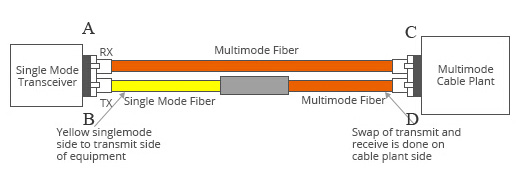Mode Conditioning Patch Cable (MCP), also known as Mode Conditioning
Patch Cord, is used in longwave/long haul (LX/LH) Gigabit Interface
Converter (GBICs and SFPs) with multimode fiber. Without using MCP,
multiple signals are generated when a singlemode laser launch into the
center of a multimode fiber. This would result in pulse broadening or
Differential Model Delay (DMD) effects which degrade the modal bandwidth
of fiber cable and limit the link span (the distance between the
transmitter and receiver) for operating Gigabit Application. Mode
Conditioning Patch Cable provides an offset singlemode to multimode
fiber connector point that eliminates the effect of DMD by launching the
singlemode laser into multimode core at a specified offset.
We
offer Mode Conditioning Patch Cables with a variety of options, from all
types of connectors to different fiber modes to different jackets to
different lengths. Available with a variety of fiber optic connectors
for your convenience including: LC/UPC, SC/UPC, FC/UPC, ST/UPC, LC/APC,
SC/APC, FC/APC, and MTRJ.
Applications
- Long Haul to Short Haul LX Gigabit Systems
- Recommended for Multimode cable runs greater than 50 feet
- Gigabit Ethernet 1000Base-LX (1300nm wavelength)
Features
- Eliminates issues related to Differential Mode Delay (DMD)
- Compliant with IEEE 802.3z
- Rugged Offset Closure with Consistent Offset
- Low Insertion Loss (<0.4dB)
- Available with 62.5/125Ám OM1 and 50/125Ám OM2 multimode cable
Specifications

|
Parameters
|
Specifications
|
|
Insertion Loss
|
Light Source
Transmission Direction
|
Testing Wavelength
|
Insertion Loss
|
|
D→B
|
850nm, 1,310nm
|
Max .≤ 0.30dB
|
|
B→D
|
850nm, 1,310nm
|
Max .≤ 0.30dB
|
|
C→A
|
850nm, 1,310nm
|
≤ 15.0dB(50/125um);
≤ 18.0dB(62.5/125um)
|
|
A→C
|
850nm, 1,310nm
|
Max .≤ 0.30dB
|
|
C→A
|
1,310nm, 1,550nm
|
≤ 2.10dB(50/125um);
≤ 2.60dB(62.5/125um)
|
|
Return Loss
|
APC≥60.0dB;UPC≥50.0dB
|
≥35.0dB
|
|
Durability
|
1,000 mating,
typical≤0.20dB
|
|
Operating Temperature
|
-20℃ to +70℃
|
|
Storage Temperature
|
-40℃ to +85℃
|
How the Mode Conditioning Patch Cable Works
The
need for this mode conditioning fiber patch cord is due to the
single-mode launch nature of the-LX or long-wave(1310nm)transceiver
modules used for Gigabit Ethernet. Launching a single-mode laser into
the center of a multimode fiber can cause multiple signals to be
generated that confuse the receiver at the other end of the fiber. In
that case,a mode conditioning patch cord eliminates these multiple
signals by allowing the single-mode launch to be offset away from the
center of a multimode fiber. This offset point creates a launch that is
similar to typical multimode LED launches.

Things to Know When Using Mode Conditioning Cables
- Mode
conditioning patch cables are usually used in pairs, which means that
you will need a mode conditioning patch cord at each end to connect the
equipment to the cable plant.
- Generally, Mode Conditioning patch cables are required for link distances greater than 984 feet(300 meters).